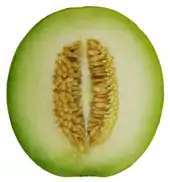Sprite melon
The sprite melon is a kind of melon, similar to honeydew, which originates from Japan. Since the late 1990s, it has been cultivated in North Carolina as a specialty crop and has increased in popularity in recent years.[1]
| Sprite melon | |
|---|---|
| Species | Cucumis melo |
| Origin | Japan |
A sprite melon has a round shape and is typically about the size of a grapefruit. It generally ranges in weight from 1.0 to 1.5 lbs. The flesh of a sprite melon is ivory in color and firm, while the peel ranges from ivory (unripe) to yellowish (ripe). As the melon reaches optimal ripeness, horizontal brown markings will appear near the stem. Sprite melon contains seeds. The firm, juicy, sweet flesh of the sprite melon is usually eaten for dessert and tends to resemble the flavor of both pears and honeydew, however it is much sweeter than either of these and can often consist of 18% sugar (25% to 30% more than other melons).[2] The melon is a part of the family Cucurbitaceae, grouped in with cucumbers, gourds, and pumpkins.[3]
| Nutritional value per 100 g (3.5 oz) | |
|---|---|
| Energy | 150 kJ (36 kcal) |
9.6 g | |
| Sugars | 9 g |
| Dietary fiber | 333 mg |
0.0 g | |
63.3 mg | |
| Vitamins | Quantity %DV† |
| Vitamin C | 51% 42 mg |
| Minerals | Quantity %DV† |
| Iron | 5% 0.7 mg |
| |
| †Percentages are roughly approximated using US recommendations for adults. Source: USDA FoodData Central | |
See also
References
- Yancey, Cecil (2002-06-05). "Melon an alternative for tobacco?". Southeast Farm Press. Retrieved 2008-07-26.
- Bare, David (2003-11-15). "Options: Conference to explore new crops". Winston-Salem Journal.
- "Sprite Melons" (PDF). School Nutrition Services – Child Nutrition. 1 Jul 2016. Archived from the original (PDF) on 1 Jul 2016. Retrieved 2 Jul 2018.
